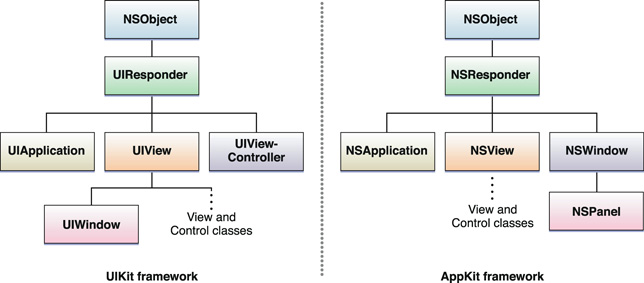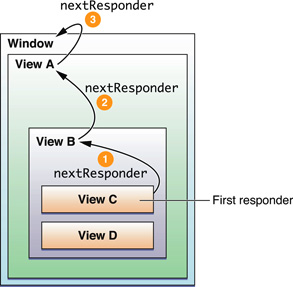Retired Document
Important: This document may not represent best practices for current development. Links to downloads and other resources may no longer be valid.
Responder object
A responder is an object that can respond to events and handle them. All responder objects are instances of classes that ultimately inherit from NSResponder (AppKit framework) or UIResponder (UIKit framework). These classes declare a programmatic interface for event handling and define a default behavior for responders. The visible objects of an application are almost always responders—for example, windows, views, and controls—and the application object is a responder as well. In iOS, view controllers (UIViewController objects) are also responder objects.

To receive events, a responder must implement the appropriate event-handling methods and, in some cases, tell the application that it can become the first responder.
The First Responder Receives Some Events First
In an application, the responder object that first receives many kinds of events is known as the first responder. It receives key events, action messages, and other kinds of events such as, in UIKit, motion and remote-control events. (Mouse events and multitouch events first go to the view that is under the mouse pointer or finger; that view might or might not be the first responder.) The first responder is typically the view in a window that an application deems best suited for handling an event. To receive an event, the responder must also indicate its willingness to become first responder; it does this in different ways for each platform:
// OS X |
- (BOOL)acceptsFirstResponder { return YES; } |
// IPhone OS |
- (BOOL)canBecomeFirstResponder { return YES; } |
In addition to receiving event messages, a responder can receive action messages that have no target specified. (Action messages are sent by controls such as buttons and controls when users manipulate them.)
The Responder Chain Enables Cooperative Event Handling
If the first responder cannot handle an event or action message, it forwards it to the “next responder” in a linked series called the responder chain. The responder chain allows responder objects to transfer responsibility for handling an event or action message to other objects in the application. If an object in the responder chain cannot handle the event or action, it resends the message to the next responder in the chain. The message travels up the chain, toward higher-level objects, until it is handled. If it isn't handled, the application discards it.

The path of an event. The general path of an event up the responder chain starts with a view—the first responder or the view under the mouse pointer or finger. From there, it proceeds up the view hierarchy to the window object and then to the global application object. However, the responder chain for events in iOS adds a variation to this path: If a view is managed by a view controller and if the view cannot handle an event, the view controller becomes the next responder.
The path of an action message. For action messages, both OS X and iOS extend the responder chain to other objects. In OS X, the responder chain for action messages differs for an application based on the document architecture, an application that uses window controllers (NSWindowController), and an application that fits neither of those categories. Additionally, if a Mac app has both a key window and a main window, the responder chain along which an action message travels might involve the view hierarchies of both windows.
Copyright © 2018 Apple Inc. All Rights Reserved. Terms of Use | Privacy Policy | Updated: 2018-04-06